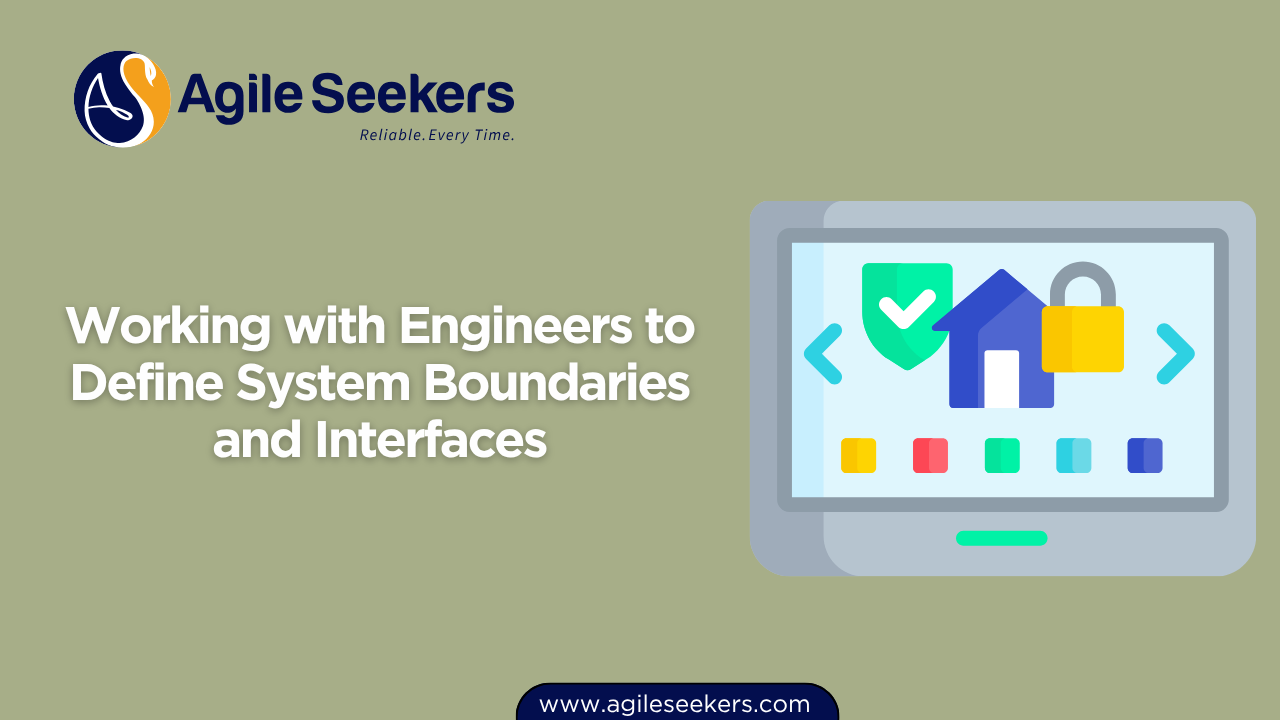Working with Engineers to Define System Boundaries and Interfaces

Defining system boundaries and interfaces is a foundational task for any successful product or system development. It’s where engineering precision meets strategic clarity. When project managers, product owners, and system architects collaborate effectively, they prevent integration mishaps, eliminate assumptions, and ensure seamless end-to-end delivery. This blog explores how product managers and engineers can work together to define clear system boundaries and interfaces.
Why System Boundaries Matter
System boundaries define what a system will do—and just as importantly—what it won’t. Without them, teams struggle with scope creep, conflicting assumptions, and integration bottlenecks. Boundaries bring clarity, align expectations, and serve as the guardrails for design and development decisions.
Establishing these limits requires deep technical insights and a strategic understanding of business value. That’s where the collaboration between engineering and product management becomes essential.
Collaborative Techniques for Defining Boundaries
1. Start with Business Capabilities
Product owners should drive discussions around business capabilities rather than jumping straight into technical architecture. Capabilities describe what the system must enable from a user or business perspective. Engineers can then map these to logical services or modules.
Example: If the capability is "customer onboarding," engineers might identify modules for identity verification, account creation, and welcome communications.
2. Define the System Context with Diagrams
Using context diagrams early on helps everyone visualize where the system begins and ends. These diagrams show external systems, users, and the high-level interactions with your system.
This technique, often emphasized in Project Management Professional certification, prevents misalignment about external dependencies or hidden scope.
3. Run Interface Definition Workshops
Facilitate focused sessions with engineers and stakeholders to define and document interfaces. These workshops cover:
-
Input/output data structures
-
API endpoints or messaging schemas
-
Communication protocols
-
Security and authentication needs
Having both engineering and product leads in these discussions ensures interfaces align with user needs and tech feasibility.
Key Considerations While Defining Interfaces
a. Contracts Over Assumptions
Every interface should behave like a contract. Whether it’s a RESTful API, a database schema, or a message queue, it must have a clear structure and behavior.
Avoid making assumptions. Misunderstandings in interface expectations are a leading cause of integration failures.
b. Versioning and Backward Compatibility
Engineering teams should design interfaces with change in mind. Introduce versioning strategies from the start, and define how older systems will continue working when interfaces evolve.
c. Security and Access Control
Security concerns must be addressed when defining system interfaces—especially in finance, healthcare, or government projects. Define who has access to which endpoints, how data will be encrypted, and how you’ll audit interactions.
Referencing the SAFe Product Owner Certification, this is also a core responsibility for Agile Product Owners managing multiple system interactions within Agile Release Trains (ARTs).
Challenges You’ll Likely Face
Misaligned Expectations
Product managers may think a feature requires a single API call, while the engineering team knows it involves multiple downstream systems and edge cases. Misalignment like this is common without regular sync-ups.
Over-Engineering Interfaces
Engineers sometimes overdesign interfaces for future use cases that may never materialize. This adds unnecessary complexity and slows down development.
Product owners should push for simplicity and design for the most probable scenarios, not edge cases.
Documentation Gaps
Interfaces often lack proper documentation, especially under deadline pressure. Use interface control documents (ICDs), OpenAPI specs, or sequence diagrams to make expectations explicit.
Tools like Swagger, Stoplight, and Postman can automate documentation, reducing friction during handoffs.
Best Practices to Strengthen Collaboration
1. Define Responsibilities Clearly
Product owners should define the "what" and "why" — the problem being solved, user goals, and business value.
Engineers take the lead on the "how" — technical feasibility, scalability, and performance.
Clearly separating concerns prevents micromanagement and fosters accountability.
2. Use Shared Glossaries and Terminologies
Misunderstandings often stem from language gaps. Use glossaries that include:
-
Domain terms
-
System component names
-
Acronyms
This practice is encouraged in SAFe POPM training to align communication across teams.
3. Include QA and Test Engineers Early
Interface definitions shouldn’t happen in a silo. Include QA engineers early to define how interfaces will be tested, mocked, and validated. This ensures testability and reduces rework.
4. Implement Iterative Interface Design
Avoid finalizing interfaces too early. Define them iteratively based on discovery during development.
Version 0.1 can be mocked, validated, and refined. By the time integration begins, you’ll have an interface that is both realistic and robust.
Real-World Example: Payment Gateway Integration
Let’s say your product team is integrating a third-party payment provider. Defining system boundaries would mean:
-
Understanding what happens inside your system vs. the provider’s
-
Clarifying failure modes and retry logic
-
Defining API contracts and response expectations
-
Addressing PCI compliance for handling payment information
Cross-functional collaboration ensures these boundaries are practical, secure, and well-understood.
This kind of integration planning is a key concept within PMP training, which emphasizes risk mitigation and stakeholder alignment.
Tools That Support Interface and Boundary Design
-
C4 Model: For visual modeling of system components and relationships
-
OpenAPI/Swagger: For defining and documenting REST interfaces
-
Figma or Lucidchart: For collaborative system diagrams
-
Confluence or Notion: For maintaining shared documentation
Outbound reference: For a comprehensive guide on interface contracts, read Microsoft's API Design Guidelines.
Conclusion
Defining system boundaries and interfaces is not a one-time task. It’s a continuous collaboration. Product managers and engineers must align frequently, document clearly, and stay flexible. This reduces surprises, accelerates delivery, and improves system resilience.
Whether you're pursuing a PMP certification to strengthen cross-functional collaboration or investing in SAFe Product Owner/Manager certification to navigate large-scale Agile environments, mastering system boundaries and interfaces is essential.
Clarity at the boundaries builds confidence in the system.
Also read - Using Architecture Decision Records (ADRs) in Product Development
Also see - Mapping Infrastructure Requirements into Product Roadmaps




















